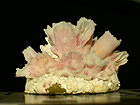

 | |||||||||||||||||||
|
|
Journals 2007/2008Beth Jewell
January 15, 2008 Jim has been working in the Galápagos for several years now to determine growth rates and survivorship of corals. He is studying the impact of oceanographic conditions on corals. During past trips he has collected corals, stained them, and then replaced them at his research sites. The following year he collected these corals to measure growth rates. He has been taking pictures on each visit to determine survivorship rates. With this baseline data he is now looking at the impact La Niña has made on the corals. The Galápagos experienced an El Niño event from December 06 to March 07. El Niños bring warmer than usual temperatures to the area and can cause coral bleaching. Corals have a narrow band of temperature in which they like to thrive. When it gets too warm or too cold they will throw the zooxanthellae that live within its tissues out. During the El Niño event the zooxanthallae increase their photorespiration, consuming more energy than they give back to the coral. Presently the Galápagos is experiencing the end of a La Niña event. The water temperature is colder than usual and from what Jim has been discovering the corals have reached the lower end of their temperature threshold and are bleaching. During the majority of his dives, he is taking pictures of the corals to measure growth and rate of survivorship.
Each time we approach an island I find myself thinking out loud how or why anyone would want to get off a ship to explore. From what I could see from the boat, the landscape was rugged and unforgiving, either dotted by cactus or covered by brush. I can only imagine how Charles Darwin and others made their way into the islands.
Jon Witman's dive notes for the day: |
||||||||||||||||||



